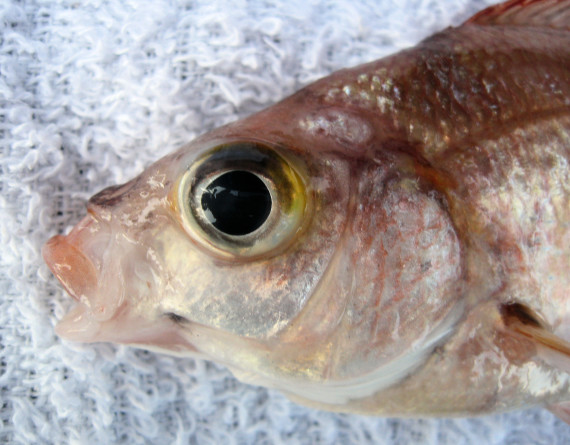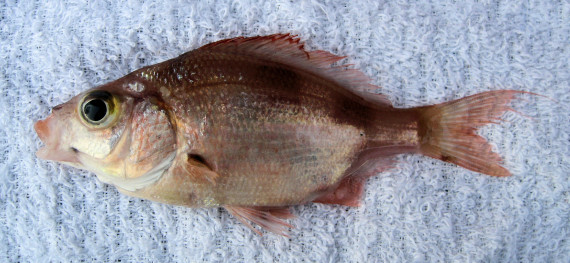Pink Seaperch, Zalembius rosaceus
 Pink Seaperch, Zalembius rosaceus. Fish caught in coastal waters in the channel between Isla Danzante and Punta Coyote, Baja California, October 2007. Length: 15.0 cm (5.9 inches). Catch, photograph, and identification courtesy of Dr. Brad Erisman, Scripps Institute of Oceanography, La Jolla, California.
Pink Seaperch, Zalembius rosaceus. Fish caught in coastal waters in the channel between Isla Danzante and Punta Coyote, Baja California, October 2007. Length: 15.0 cm (5.9 inches). Catch, photograph, and identification courtesy of Dr. Brad Erisman, Scripps Institute of Oceanography, La Jolla, California.
The Pink Seapeach, Zalembius rosaceus, is a member of the Surfperch or Embiotocidae Family, that is also known as the Pink Surfperch and in Mexico as mojarra rosada. There is only one global member in the genus Zalembius, the species described herein, which is found in Mexican waters of the Pacific Ocean.
The Pink Seaperch have highly compressed elongated oval bodies with a depth that is 37% to 41% of standard length. They are pinkish-red and transition to white around the ventral portion of their head. They have a pair of dark spots under the center and rear of their dorsal fin and a dark bar at the base of their caudal fin. Their dorsal and ventral profiles are gently convex. Their head is small with a conical and bluntly pointed snout and disproportionately large horizontal eyes. Their mouth opens at the front and has jaws of equal size that do not reach the eyes. Their anal fin 3 spines, the third being the longest, and 20 rays with a short base with an “S” shaped margin; their caudal fin is forked and has a short narrowing and tapering base and a longer top lobe; their dorsal fin has 10 spines and 18 soft rays with a long base with the middle spines being longer than the soft rays and continuous; and, their pelvic fins are inserted behind the pectoral fins. Males have extended anal and caudal fin rays. They have 16 to 19 gill rakers. Their body is covered with smooth scales. Their lateral line is complete and high on the body.
The Pink Seaperch are typical inhabitants of rocky reefs and open trawl grounds. Juveniles are found in the surf zone and adults move offshore at depths up to 275 m (900 feet), which is much deeper than where other surfperch are found. They reach a maximum of 20.6 cm (8.1 inches) in length. Their dietary habits have not yet been studied. Reproduction is viviparous. Mating occurs in the spring with gestation periods of 5 to 7 months. Each female produces 2 to 6 fry that are 3.4 cm (1.4 inches) in length and born in winter. The Pink Seaperch is of scientific interest because of the timing of the various events of their annual reproductive cycle.
The Pink Seaperch is a resident of Mexican waters of the Pacific Ocean but has a limited distribution being found only from Guerrero Negro, Baja California, northward along the central and northwest coasts of Baja and there is a very small population in the greater Santa Rosalia, Baja California Sur, area within the Sea of Cortez.
The Pink Seaperch is straightforward to identify due to its body profile and coloration and is therefore not easily confused with any other species.
From a conservation perspective the Pink Seaperch is currently considered to be of Least Concern with stable, widely distributed populations. They are exceedingly rare and small in stature and seldom seen by humans. They are caught on a limited basis as a by-catch of deep water trawlers.
